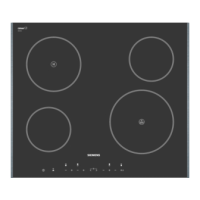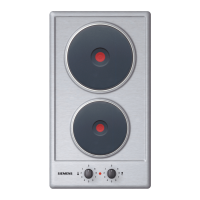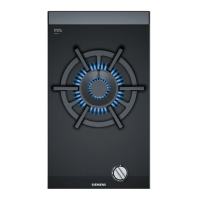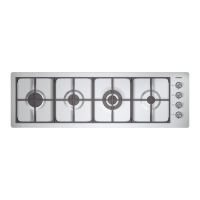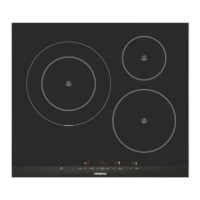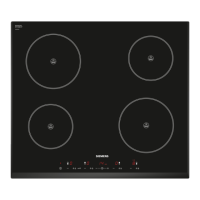Do you have a question about the Siemens ET 735 Series and is the answer not in the manual?
Guidance on preparing the appliance for use, including checks and connections.
Essential safety rules and warnings for operating the hob, including fire risks.
Warnings about touching hot hotplates and potential fire hazards from combustible items.
Hazards of electric shock from cracked glass ceramic and immediate actions to take.
Warnings against unauthorized repairs and the importance of using qualified technicians.
How rough pan bases and using empty pans can damage the hob surface.
How sugary food spills can damage the hob and the need for immediate cleaning.
Overview of various types of damage that do not affect hob function.
Overview of the hob's control panel, its symbols, and indicators for operation.
Descriptions of different hotplate types: single, dual, and tri-circuit.
Explanation of the residual heat indicator and its levels.
How to switch the hob on and off using the main switch.
How to activate and operate the childproof lock to prevent unintended use.
Detailed steps for setting the desired heat level for a hotplate.
A table providing cooking examples with quantity, heat settings, and times.
Advice on how to cook more efficiently and save energy.
Step-by-step guide to activate and use the electronic boil start control.
How to set a specific cooking time to automatically switch off a hotplate.
Steps to set the cooking timer for a duration up to 99 minutes.
How to store heat settings and times for a meal for future recall.
How to recall stored cooking programs and view their settings.
Explanation of the automatic time limiter feature and its indicators.
Procedure to disable the acoustic confirmation signal for button presses.
Recommendations for using protective/care products for the glass ceramic surface.
How to clean the glass ceramic hob surface after each use.
How to clean the hob surround using warm soapy water.
Initial checks for when the hob is not functioning, like fuses or power cuts.
Troubleshooting steps for a flashing indicator and 'E' error code on the control panel.
Explanation of error codes 'E' and 'F' and their corresponding actions.
Guidelines for environmentally sound disposal of packaging and appliances.
Information on what product and production numbers to quote when contacting after-sales service.
Explanation of how acrylamide forms in food during preparation.
Identification of food types most affected by acrylamide formation.
General recommendations to minimize acrylamide levels during cooking.
Specific advice for deep-fat frying to reduce acrylamide formation.
Recommendations for shallow frying potatoes to minimize acrylamide.
| Type | Induction hob |
|---|---|
| Number of Cooking Zones | 4 |
| Control Type | Touch control |
| Boost Function | Yes |
| Residual Heat Indicator | Yes |
| Timer | Yes |
| Automatic Pan Detection | Yes |
| Dimensions (H) | 51 mm |
| Color | Black |
| Safety Features | Overheat protection |
| Power Consumption | 7.2 kW |


